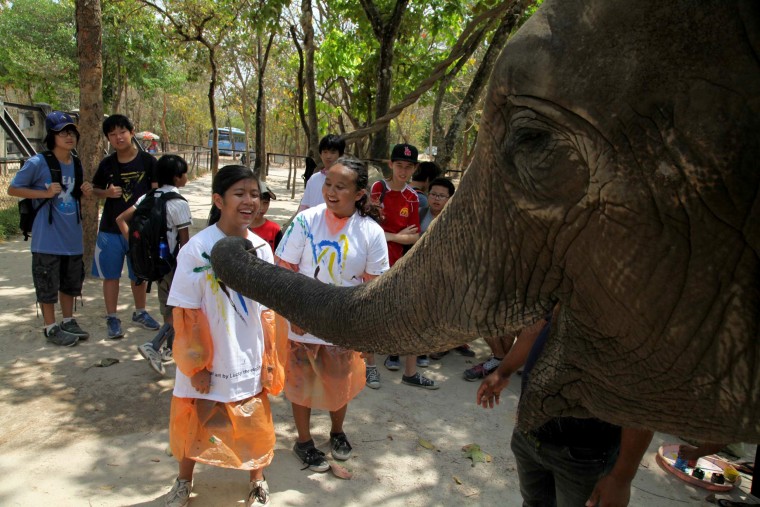PHNOM TAMAO, Cambodia — Lucky the elephant made her way slowly down a forest path, pausing to throw dust over herself before pulling up big clumps of grass, using her trunk to scoop it to her mouth.
Nick Marx looked on, letting her bide her time, and relishing the moment.
"We are so happy to see this natural behavior," he said. "At the moment she really looks like she is on the mend."
Yet just days earlier, Marx, wildlife rescue director at Cambodia's Phnom Tamao Wildlife Rescue Center, doubted Lucky would survive.
"In the really bad times I was thinking, she's going to die," he told NBC News.

Lucky has been battling a series of illnesses, which started with a usually fatal elephant virus, supported by Marx and a team of passionate keepers for whom she been a symbol of the rescue center and of conservation.
"She's become the iconic animal," Marx said. "Everybody loves Lucky."
Now 15 years old, she was found abandoned at 6 months old after her mother was likely killed by poachers.
She was reared by keepers at the rescue center, where she grew into a popular and gentle giant, beloved by staff and visitors.
She even acted at times as a surrogate mother to other injured elephants that passed through the center.
When one young male arrived, his leg so badly mangled by a trap that it had to be amputated and replaced by a specially constructed prosthetic, Lucky acted as his guide and mentor.
"She rarely left his side," Marx recalled.
Her keepers were devastated when she fell ill earlier this year. For weeks, Marx and his team battled to keep the plucky pachyderm alive.
"I was sleeping in a hammock along with the keepers every night," Marx said. "It's been a real battle, a real battle."
She stopped eating. And was soon being fed — and medicated — through an intravenous drip into veins in her ear.
The $40,000 cost of her treatment quickly drained the resources of the rescue center — and Marx's savings.
But Lucky had another rare skill — as an artist. She'd been taught to paint on canvases as well as T-shirts.

Lucky was taught to paint using a rewards-based system — often in the form of doling out her favorite fruit treats as a means of reinforcement.
And she quickly caught on.
As money ran low, the New York-based Wildlife Alliance, which supports the center, raised more than $1,100 for her treatment by auctioning two of her paintings.
Which, as far as anybody knows, is a record for original works by an elephant.
It was earlier this month that Lucky showed the first signs of recovery: Flapping her ears, showering herself and feasting on that grass.
"We're just happy that there's progress, and we look like we're winning," Marx said.
And another sign of progress: During a visit by NBC News she raised a paint brush for the first time in weeks, slapping on the paint for a rather unique piece of art on a T-shirt worn by an NBC correspondent.
Marx remains cautions. Lucky is still on steroids and there have been ups and downs before.
"She's become the iconic animal. Everybody loves Lucky."
Most of the other 1,200 animals who share this vast rescue center close to the Cambodian capital Phnom Penh — from bears to baboons to rare birds — were confiscated from illegal wildlife traders or found injured in the Southeast Asian nation's rapidly disappearing forests.
The center runs a rehabilitation program that aims to return as many as possible to the wild, though others have been too badly hurt for that to be possible.
The illegal wildlife trade is a huge and lucrative business in this region.
But the tentative recovery by Lucky, the star of the center, is bringing hope and cheer to those overseeing this diverse collection of refugees.
"Now there's a smile on everyone's face — and on Lucky's, too," said Marx, as Lucky flapped her ears and extended her trunk for him to stroke. Just like in the old days.
